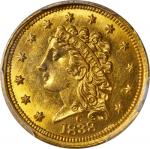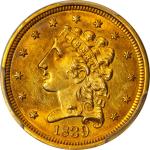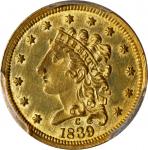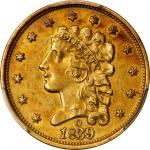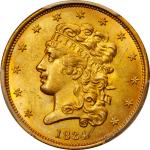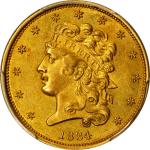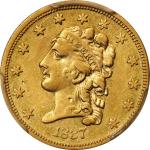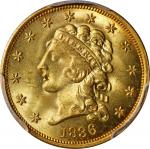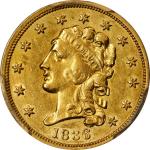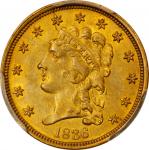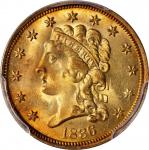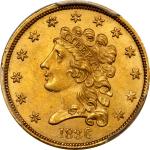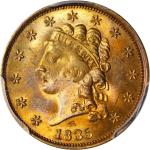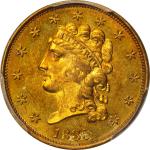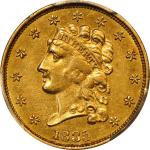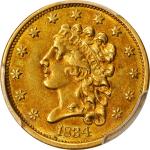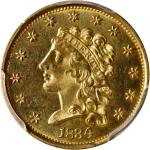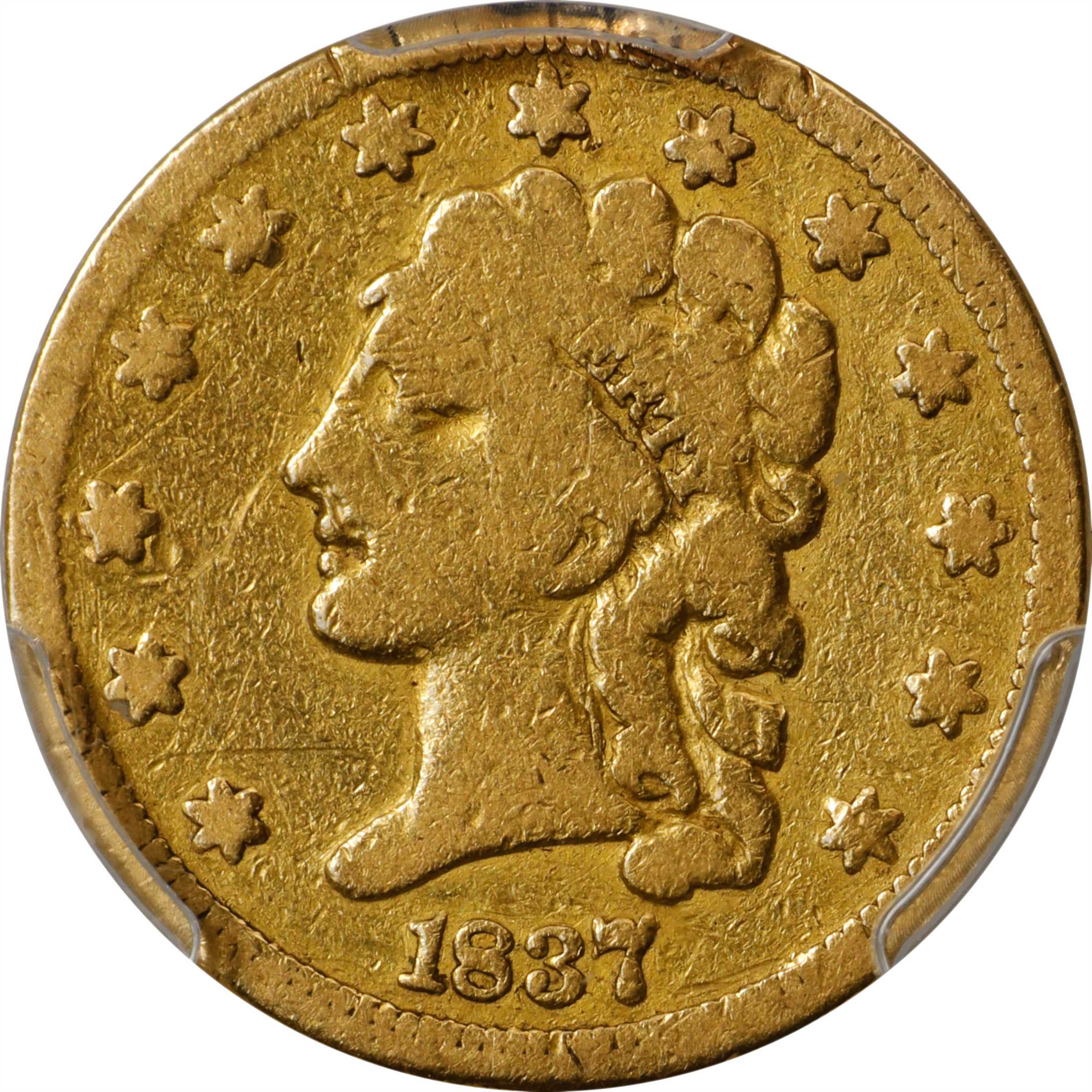1837 Classic Head Quarter Eagle. HM-3, JD-1. Rarity-7. AG Details--Mount Removed (PCGS). <strong>Die Variety:</strong> HM-3, JD-1. Obverse 2: The date is centered in the field between the border and the base of Libertys portrait, with the digit 7 centered below the extreme left edge of the lowest hair curl. Star 3 is very close to the dentils, star 6 points to the upper third of the headband, and star 7 points to the middle of the foremost hair curl on top of Libertys head. Additional diagnostics of this obverse die include repunching on the letters TY in LIBERTY, stars 8 and 9, and the digits 8 and 7 in the date. This die appears only in the present pairing. Reverse H: Unlike the two reverse dies used for the other varieties of the 1837 quarter eagle, the reverse die of HM-3 has only two pale gules in the shield stripes. There is a tongue in the eagles mouth, the lowest arrow tip is below the inside right base of the final letter A in AMERICA, the tip of the branch stem below the eagle is over the extreme left edge of the letter D in the denomination, and the lowermost arrow feather ends over the center of the primary digit 2 in the denomination. Reverse H also appears in the 1838 HM-1 variety, the only one known for that issue.<p><strong>Die Emission Sequence: </strong>With no shared dies, it is not known when the 1837 HM-3 variety was struck relative to the HM-1 and HM-2 pairings of the issue. Its Proof status means that it is presumably a product of calendar year 1837, however, and was thereby struck before the 1838 issue, with which it shares a reverse die.<p><strong>Die State: </strong>Surprisingly for an issue with so few survivors, there are two obverse die states known for the 1837 HM-3 quarter eagle, both associated with variations in striking quality. The earlier of these two die states is represented by the Eliasberg-Bass and National Numismatic Collection (NNC) specimens listed below, as well as the present example from the Virginian Collection. A single obverse die crack is noted on all three of these coins, originating at the border outside star 8, bisecting the back of Libertys portrait (extending through the letters TY in LIBERTY in the process), and terminating at the flag of the digit 7 in the date. The NNC and Virginian specimens have approximately 17 degrees counterclockwise rotation of the dies.<p>For the later obverse die state of this variety, represented by the Ferrendelli specimen listed below, the aforementioned bisecting crack extends through the flag of the 7 in the date to the lower border below that digit. There is a second, even more prominent crack that begins at the border outside star 6, bisects the two rightmost points of that star, curves slightly to cross into Libertys portrait at the forelock, continues down through Libertys nose, mouth, and chin, and then arcs to the lower left border just before star 1. The Ferrendelli specimen was clearly struck after the Eliasberg-Bass and NNC coins, and there were at least two different striking periods for the Proof 1837 HM-3 quarter eagles.<p>John W. Dannreuther (<em>United States Proof Coins, Volume IV: Gold</em>, 2018) notes a single, perfect reverse die state for this issue, although our examination of the Ferrendelli specimen in 2014 revealed a short, faint crack in the lower field before the primary digit 2 in the denomination that joins neither the border nor any of the surrounding devices. This crack also appears to be present on both the Eliasberg-Bass and NNC specimens. The level of preservation precludes definitive reverse die state attribution of the Virginian Collection coin, although it appears to be perfect.<p><strong>Estimated Surviving Population for the Variety: </strong>Just six specimens are positively confirmed to exist, as follows:<p>1 - <strong>PCGS</strong><strong> Proof-66+ Deep Cameo. CAC. The Eliasberg-Bass Specimen. </strong><em>Ex New York Coin and Stamp Companys sale of the Lorin G. Parmelee Collection, June 1890, lot 1071; S.H. and H. Chapmans sale of the John G. Mills Collection, April 1904, lot 552; John H. Clapp Collection; Louis E. Eliasberg, Sr., acquired in 1942 when he bought the Clapp Collection intact; our (Bowers and Ruddys) sale of the United States Gold Coin Collection (Eliasberg), October 1982, lot 104; Harry W. Bass, Jr.; our (Bowers and Merenas) sale of the Harry W. Bass, Jr. Collection, Part III, May 2000, lot 94; Terry Brand; our (American Numismatic Rarities) Classics Sale of July 2003, lot 643; unknown intermediaries; Todd Griffiths (CT Group), November 2010, to the following; Brian Hendelson, April 2011; </em><em>Joan Zieg Steinbrenner; Heritages sale of the Joan Zieg Steinbrenner Collection, August 2019 Chicago ANA Signature Auction, lot 3840</em>.<p>Prior to 2013, the Eliasberg-Bass specimen was the only Proof 1837 quarter eagle in private hands, and it remains the finest known survivor of this exceedingly rare issue. The coin has passed through several different third-party grading holders since it was first certified prior to the Bass Collection sales. Certified Proof-65 by PCGS when offered in Part III of the Bass Collection (May 2000), the coin was subsequently upgraded to Proof-66 Deep Cameo at PCGS during collector Terry Brands ownership. It was in that grade when we (American Numismatic Rarities) offered the coin in our July 2003 Classics Sale, although a notation in our cataloging for that sale stated that the coin passed through an NGC Proof-66 Cameo (or Ultra Cameo?) holder before temporarily settling in as PCGS Proof-66 Deep Cameo. When owned by Todd Griffiths between November 2010 and April 2011, the coin was recertified yet again, this time as NGC Proof-67 Ultra Cameo. This is the grade at which Griffiths sold the coin to Brian Hendelson. When sold in Heritages August 2019 Chicago ANA Signature Auction, the grade had changed yet again, this time to PCGS Proof-66+ Deep Cameo, and with CAC approval.<p>The Eliasberg-Bass specimen represents the earlier of the two known obverse die states of the 1837 HM-3 Classic Head quarter eagle.<p>2 - <strong>NGC Proof-63 Cameo. The Lipton-Griffiths-Hunt Specimen.</strong><p>This Proof first came to light during the January 2013 FUN Convention. It was confirmed as a Proof striking of the 1837 Classic Head quarter eagle and certified Proof-63 Cameo by NGC, passing through the hands of dealers Kevin Lipton and Todd Griffiths during the course of the convention. At the time of its discovery and certification, this coin was only the third known Proof 1837 quarter eagle, and the second in private hands. Pictured on page 155 in Haynors reference, it too was struck from the HM-3, JD-1 die pairing, as are all other Proof 1837 quarter eagles known, and has been verified to be from the earlier stage of the dies with just the single die crack from star 8 to the numeral 7.<p>3 - <strong>Proof-63 Deep Cameo, Rim Damage</strong><strong>. The National Numismatic Collection Specimen.</strong> <em>Ex Adam Eckfeldt, chief coiner of the United States Mint (presumably); U.S. Mint Cabinet, begun in June 1838 by Eckfeldt; The National Numismatic Collection, Smithsonian Institution</em>.<p><p>Along with the Eliasberg-Bass specimen, this coin was one of only two Proof 1837 quarter eagles positively confirmed to exist prior to January 2013. It represents the earlier known obverse die state of the issue, along with the Eliasberg-Bass and Virginian Collection specimens.<p><p>According to Jeff Garrett and Ron Guth (2008), this coin, "would probably grade Proof-64 were it not for heavy rim damage on the right side of the obverse." This area of damage is located exactly at 3 oclock, almost perfectly centered on star 11.<p>4 - <strong>AU-55. The Bonhams Specimen. </strong><em>Ex Bonhams sale of December 2010, lot 2271; Eastern Collection</em>.<p>This specimen is double struck on the obverse, with noticeable doubling on the stars and digits in the date. Both the coins attribution and probable Proof status were overlooked in the catalog.<p>5 - <strong>PCGS Proof. AU Details--Graffiti. The Ferrendelli Specimen.</strong> <em>Ex H. Field, December 1961; Heritages sale of the John H. Schroeder Collection, January 2006 FUN Signature Auction, lot 4707; Ron Karp and David McCarthy, to the following via private treaty sale; Dr. James A. Ferrendelli; our sale of the Dr. James A. Ferrendelli Collection, August 2014 Chicago ANA Sale, lot 11045, unsold</em>.<p>At the time of its offering in the January 2006 Heritage auction, this coin was certified AU-50 Details--Graffiti, Cleaned by ANACS. The die variety was confirmed by the Heritage catalogers, who described this coin, in part, as:<p><p><em>"Probable Proof 1837 Quarter Eagle... Possibly a Proof-Only variety... This is only the third example of the die marriage that we have seen or heard of... If we are correct in our analysis, this is an incredibly important opportunity for those collectors of Classic Head Quarter Eagle varieties… a recent phone call from John McCloskey, who is currently preparing a manuscript on the Classic Head Quarter Eagles, confirms our analysis."</em><p>Dr. Ferrendelli acquired this coin via private treaty after the Heritage sale in the firm belief that it was a Proof, and it was our pleasure to confirm his belief by working with PCGS to have this coin certified as a Proof for our August 2014 offering of the Ferrendelli Collection. At the time of its certification by PCGS, this coin became the fourth confirmed Proof 1837 quarter eagle. As previously stated, this coin represents the later known obverse die state of the issue, and it was certainly struck after the Eliasberg-Bass, NNC and Virginian Collection specimens.<p>6 - <strong>PCGS AG Details--Mount Removed. The Virginian Collection Specimen.</strong> <em>Ex our Chicago ANA Auction of August 2019, lot 2016; the Virginian Collection. <strong>The present example</strong></em>.<p>This coin was discovered by the consignor to our August 2019 Chicago ANA Auction, in which it was certified Good Details--Mount Removed by NGC. The HM-3 die pairing was confirmed by Stacks Bowers Galleries during cataloging for that sale. The level of preservation precludes confirmation of the original mint finish or method of manufacture, thereby explaining why it has not been certified as a Proof by either PCGS or NGC.<p><strong>Strike: </strong>The obverse retains a sharp date and bold outline detail to all other major design elements; the letters ERTY in LIBERTY are discernible. The reverse above the eagle is worn smooth with the words STATES OF in the legend no longer evident. The eagle itself is fully outlined, the words UNITED, STATES and the denomination 2 1/2 D. legible. As well, perhaps the most significant diagnostic of the HM-3 attribution is readily evident -- the shield on the eagles breast has two pale gules in the stripes as opposed to three as seen on HM-1 and HM-2 quarter eagles of this date.<p><strong>Surfaces: </strong>Obviously a former jewelry piece, both sides of this coin are curiously glossy with numerous handling marks peppering the surfaces. The NGC qualifier concerns a mount removal at 12 oclock relative to the obverse. Honey-gold color overall with a hint of underlying olive.<p><strong>Commentary: </strong>All confirmed examples of the 1837 HM-3 die marriage are either Proofs or presumed Proofs, although admittedly the Virginian Collection specimen is at such a level of preservation that the original finish and method of manufacture are no longer discernible. As one of only six coins known of a pre-1859 Proof gold issue, however, its importance cannot be overstated. The coin is a major numismatic rarity, to be sure, and it would serve as a highlight in an advanced collection of Proof gold despite its preservation.<p>All known Proof 1837 quarter eagles are more or less softly struck in and around the centers on both sides. This is due to the presence of one or both of the aforementioned obverse die cracks that are associated with the surviving examples. These cracks interfered with metal flow into the deepest recesses of the dies during striking and, hence, resulted in incomplete definition to the highest elements of the design. The latest known die state for the issue with the most advanced cracks, represented by the Ferrendelli specimen, is the most softly struck of the high grade examples that we have been able to examine either in person or through high-quality images. On the obverse, Libertys hair curls above and below the headband are quite soft, as are those at the back of the neck. The leading half of the headband itself is also very weak with the letters L and E soft, the top half of the I indistinct, and the B so faint as to be almost indistinguishable. The reverse exhibits a similar quality of strike in this late die state with the left shield border indistinct, as well as the adjacent feathers in the eagles left (facing) wing and left (facing) leg. The left (facing) leg, in particular, is blunt and devoid of detail, although a loupe does reveal some detail in the talons. Additionally, the eagles neck feathers are a bit softly defined, though some bolder definition is noted in that area.<p>For the earlier die state, represented by the Eliasberg-Bass, NNC and Virginian Collection specimens, the detail to Libertys hair curls above and below the headband is a bit sharper, and there is emerging definition to the feathers in the eagles leg wing at the junction with the shield and in the left leg above the talon (all where allowed by level of preservation).<p>It might seem odd given the great pride of workmanship that goes into the production of modern U.S. Mint Proof coinage that a Proof gold coin from any year in our nations history could be produced with both prominent die cracks and softly struck devices. The Mint of the 1830s had not yet developed the high standards that would come to characterize its Proof coinage in later decades, even those of the mid-to-late 19th century. To be sure, the Mint used carefully prepared, highly polished dies and planchets to strike the confirmed Proof 1837 quarter eagles, but even so, a noticeably cracked obverse die was deemed acceptable for the production of special coins such as these. Given the fact that the NNC specimen was probably the first Proof 1837 quarter eagle struck, we believe that the obverse die for this issue was cracked from the start, probably due to imperfections in the steel from which it was fashioned. Subsequent strikings at a later date resulted in the formation of a second, even more prominent bisecting crack on that side. In keeping with yearly Proof gold deliveries throughout the 1830s, the Mint obviously expected to strike very few Proof quarter eagles in 1837. Rather than discard a usable die, even a flawed one, this obverse was deemed acceptable for striking a small number of these special coins and was indeed used for that purpose on at least two different occasions.<p>As with all pre-1859 Proof gold coins, the exact mintage of the Proof 1837 Classic Head quarter eagle is unknown. Prior to 1859, Proof gold coins were made in extremely small quantities, and often only for presentation purposes as collector demand at the time was virtually non-existent. As the different obverse die states of the Proof 1837 quarter eagle discussed above confirm, these coins were struck on at least two different occasions during the year, the Mint obviously producing a few coins at a time on an as-needed basis. Given the paucity of surviving examples and the extreme unlikelihood that a specially made Proof gold coin issue from the 1830s would have suffered a high rate of attrition, the mintage of the Proof 1837 quarter eagle was probably on the order of just six to eight specimens.<p>The extreme rarity and circumstances under which it was struck are only part of the history and desirability of the 1837 HM-3 quarter eagle from the Virginian Collection. Just as interesting is what happened to this coin after it was struck, and both the mount removal and existence of at least one other Proof 1837 quarter eagle that was used as a jewelry piece provide the basis for conjecture on at least part of this coins journey after leaving the Mint. In our August 2014 offering of the Ferrendelli specimen, your cataloger (JLA) wrote the following concerning the initials E.A.G. in the upper reverse field on that coin:<p><em>"Although [these initials] presence on this coin explains the [Graffiti] qualifier from PCGS, a broader perspective and consideration for history allows one to see that these initials only add to the interest, allure, and desirability of this Proof quarter eagle. The expert engraving of the initials on this coin suggests that they were added to further define it for special presentation purposes, likely of a personal nature, and probably as a gift or token of affection. The engraving was almost certainly done long ago, at a time when the numismatic rarity and value of the Proof 1837 quarter eagle had not yet been established, and most likely shortly after striking. It is not too difficult for us to imagine that someone deliberately sought out and obtained a special gold coin (read: Proof striking) for use as a gift, token of affection, or similar purpose. The gifting party had the initials of the recipient E.A.G. carefully engraved into the upper reverse field. Given the extremely limited mintages of early Proof gold coins and their equally limited distribution, it may be that the presenter and/or recipient of this gift had connections to the Mint. The recipient obviously handled this piece for a period of time after receiving it, as evidenced by its level of preservation. However, enough detail remains to suggest that for most of its life this coin has remained carefully tucked away. It is likely that it remained with the family of the original recipient whose initials are E.A.G. before finding its way into numismatic hands at a much later date."</em><p><em></em>Although only conjecture, the foregoing provides a possible scenario to explain the level of preservation of the Proof 1837 quarter eagle that we are offering in this lot. It seems probable that a few of the Proof quarter eagles struck in 1837 were sought out for and used as jewelry pieces. Perhaps they were struck with that very purpose in mind, at the request of someone with close ties to the Mint, or perhaps they were obtained at a later time for this purpose, but certainly during an era when the numismatic rarity and value of Proof Classic Head quarter eagles had not yet been established. We will likely never know the true story of this coin and how it came to be mounted as jewelry and obviously used in that manner for an extended period of time. The mystery surrounding its history after leaving the Mint only adds to the appeal of this rare early Proof gold coin, a highlight of the Virginian Collection. PCGS# 7695. NGC ID: 25FX. From the Daryl J. Haynor Virginian Collection. Earlier from our ANA Auction of August 2019, lot 2016.

